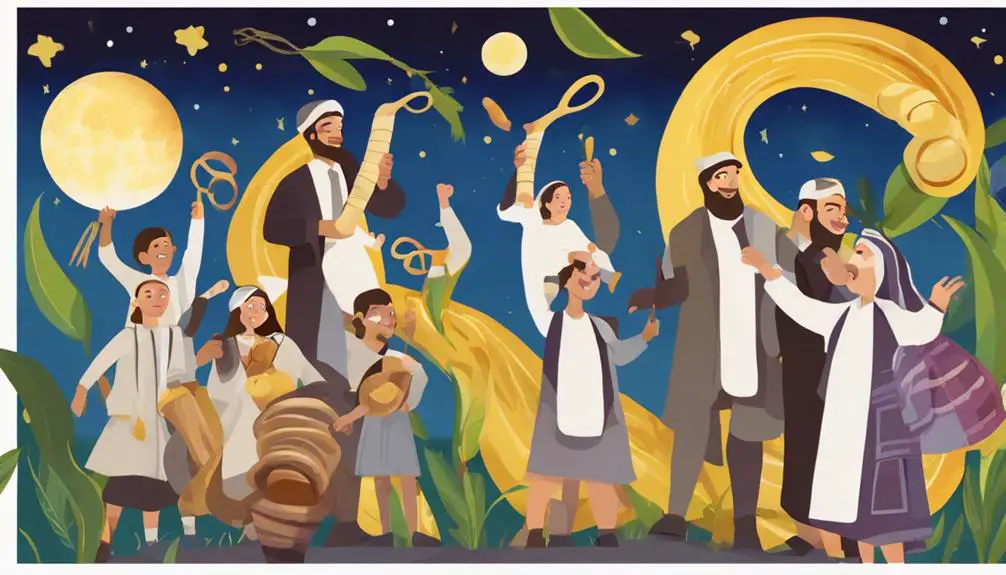Yearn to understand the Bible's spiritual symbolism? Explore Tishri, the seventh Hebrew month, and its transformative significance in biblical texts.
Tishri in the Bible
Have you ever considered the significance of Tishri, the seventh month in the Hebrew calendar, as mentioned in the Bible? It's a time of reflection, repentance, and renewal for many Jewish believers.
Some scholars suggest that Tishri carries a unique symbolic weight in biblical texts. What if this month isn't just about the High Holy Days but also serves as a subtle metaphor for spiritual transformation? Intriguing, isn't it?
Let's unpack this idea together and see what treasures we might uncover in the process.
Key Takeaways
- Tishri holds significant biblical symbolism, representing judgment, repentance, and divine protection.
- Major Tishri holidays like Rosh Hashanah, Yom Kippur, and Sukkot play pivotal roles in Jewish faith and practice.
- Spiritual practices during Tishri guide Jews through reflection, atonement, and renewal, fostering a deeper understanding of their faith.
- The High Holy Days in Tishri, as per the Bible, offer opportunities for self-examination, reconciliation with God, and a renewal of faith.
Understanding the Month of Tishri

To fully grasp the significance of Tishri, you must delve into both its biblical context and its modern-day observance in Jewish culture. As the seventh month in the Hebrew calendar, Tishri's significance is rooted in its multifaceted nature. It's a month filled with solemn reflection, joyous celebrations, and pivotal observances.
Tishri observances are a fusion of the past, present, and future, each carrying distinct symbolic meanings. The ten-day period starting with Rosh Hashanah (New Year) and culminating in Yom Kippur (Day of Atonement) is a profound reflection of Tishri's significance. This period, often referred to as the 'Days of Awe,' is a time for introspection, repentance, and forging a path towards spiritual renewal.
The festival of Sukkot, which also falls in Tishri, is a celebration of the divine protection offered to the Israelites during their exodus from Egypt. It's an opportunity to express gratitude for life's blessings and the sustenance provided by the harvest.
Understanding Tishri isn't just about recognizing these observances but also acknowledging their profound effect on Jewish identity and spirituality. These traditions serve as a bridge, connecting Jews to their ancestral past and guiding their moral and spiritual journey into the future.
Biblical References to Tishri

Examining the biblical allusions to Tishri, you'll find it's more than just a month – it's a symbol of spiritual reflection and renewal, deeply embedded in Jewish history and traditions. The Tishri prophesies and references in Exodus provide an analytical viewpoint to study this sacred significance.
In the Bible, Tishri is often referenced in prophesies, symbolizing a time of judgment and repentance. For example, the Day of Atonement, Yom Kippur, occurs in Tishri and is a day prophesied for forgiveness and reconciliation with God.
The Book of Exodus also mentions Tishri, particularly highlighting the Feast of Trumpets (Rosh Hashanah), a time of shouting and rejoicing in the Lord. It's clear that Tishri holds a unique place in Jewish religious practices and prophecies, setting the stage for spiritual awakening.
Consider the table below for a brief overview:
Biblical References |
Significance |
|---|---|
Tishri Prophesies |
Time of judgement and repentance |
Yom Kippur in Tishri |
Day of forgiveness and reconciliation |
Tishri in Exodus |
Highlights Feast of Trumpets |
Feast of Trumpets |
Time of rejoicing in the Lord |
With these references, we can see Tishri's profound importance in the biblical narrative and Jewish faith.
Major Holidays in Tishri

Several significant holidays fall within the month of Tishri, each carrying deep historical and religious meaning in the Jewish faith. The Tishri celebrations begin with Rosh Hashanah, marking the Jewish New Year. This festival is a time of introspection, and the sounding of the shofar serves as a call to repentance.
Next, you'll find Yom Kippur, the Day of Atonement. This is the most solemn day of the Jewish year, dedicated to fasting, prayer, and repentance. The Feast significance is profound; it's a day for making amends and seeking forgiveness.
The joyous holiday of Sukkot follows, celebrating the harvest and commemorating the forty years of Jewish wandering in the desert. This feast is marked by the building of temporary shelters, or 'sukkah', in which meals are eaten and prayers are offered.
Finally, Tishri concludes with Shemini Atzeret and Simchat Torah, celebrating the end of the yearly Torah reading cycle and the beginning of a new one. This is a time of rejoicing and dancing with Torah scrolls.
These Tishri holidays, steeped in tradition and religious symbolism, form a critical part of the Jewish liturgical year.
Tishri's Role in Jewish Tradition

Beyond the numerous holidays it hosts, the month of Tishri holds a distinctive place in Jewish tradition, acting as a spiritual compass guiding the community through a cycle of reflection, atonement, celebration, and renewal. Tishri's significance isn't merely historical or ritualistic; it embodies a profound spiritual journey that every practicing Jew undertakes.
Tishri's customs reflect this journey. The month starts with Rosh Hashanah, a sanctuary for self-reflection and introspection. You're called to review your past year's actions, seek forgiveness, and make resolutions for the upcoming year. Ten days later, Yom Kippur, the Day of Atonement, provides a platform for you to repent and make amends.
Communal celebrations and renewal come next with Sukkot, a week-long festival of gratitude, rejoicing, and unity. It's a time when you're reminded of the impermanence of material possessions and the importance of community. Lastly, Simchat Torah marks the renewal of the annual Torah reading cycle, symbolizing the continuous quest for knowledge and understanding.
In essence, Tishri ushers you through a spiritual trajectory of introspection, repentance, gratitude, celebration, and renewal. This cyclical journey is a cornerstone of Jewish tradition, underscoring Tishri's pivotal role. Each custom during Tishri is a stepping stone in this spiritual odyssey.
Symbolism of Tishri in the Bible

In the scriptures, the symbolism of Tishri offers a rich tapestry of spiritual insights, weaving together elements of reflection, atonement, and renewal. Tishri's significance is not only historical but also deeply symbolic, serving as a gateway to profound Biblical interpretations.
Symbol |
Biblical Interpretations |
Tishri's Significance |
|---|---|---|
Reflection |
Tishri's first ten days, known as the High Holy Days, provide an opportunity for self-examination. |
It signifies the start of a spiritual journey. |
Atonement |
Yom Kippur, on Tishri's 10th day, is the Day of Atonement, underscoring the theme of reconciliation. |
It symbolizes God's forgiveness and the chance to mend our ways. |
Renewal |
The start of Tishri marks the beginning of the Jewish New Year, Rosh Hashanah. |
It signifies a fresh start, a renewal of faith and commitments. |
Each aspect of Tishri holds deep spiritual implications, encouraging self-reflection, promoting atonement, and offering a chance for renewal. This symbolic understanding of Tishri in the Bible enhances your appreciation of its profound spiritual depth, adding another layer to your knowledge about this sacred month.
Frequently Asked Questions
What Are Some Common Customs and Traditions Practiced During Tishri That Are Not Mentioned in the Bible?
You're exploring Tishri symbolism and unscriptural Tishri rituals. Some traditions aren't directly mentioned in the Bible.
For instance, the blowing of the shofar, a ram's horn, is a common custom. There's also Tashlich, the practice of casting off sins into a body of water. Sukkot's Ushpizin ritual, inviting biblical guests into the Sukkah, is another.
These rituals, while not biblical, have become integral parts of the Tishri observances.
How Has the Significance of Tishri Evolved Throughout Jewish History?
You've asked about the evolution of Tishri's significance in Jewish history.
It's interesting how Tishri symbolism, often shaped by Biblical references, has changed over time.
Originally, it marked the start of the agricultural year. But over centuries, it evolved to include religious observances like Rosh Hashanah and Yom Kippur.
Now, it's a time for spiritual reflection and seeking forgiveness.
The richness of Tishri's history truly showcases the adaptability of Jewish tradition.
Can You Provide a Detailed Comparison Between Tishri Celebrations in Different Jewish Communities Worldwide?
You're examining Tishri celebrations globally, focusing on their unique characteristics.
It's fascinating to see the variations in Tishri symbolism and Tishri's astrological significance in different communities. Some emphasize spiritual aspects, others cultural traditions.
While the core purpose remains, the interpretations and practices vary greatly. This showcases not only the diversity within the Jewish community worldwide, but also how traditions evolve and adapt over time and place.
Are There Any Specific Foods or Recipes Associated With the Month of Tishri That Are Not Mentioned in the Bible?
Yes, there are specific foods associated with Tishri not mentioned in the Bible. They're tied to cultural traditions and Tishri dietary restrictions.
For instance, apples and honey symbolize a sweet new year during Rosh Hashanah, which falls in Tishri. Symbolic foods' significance varies across Jewish communities, reflecting diverse interpretations and customs.
The Bible doesn't provide specific recipes, but these foods have become an integral part of Tishri observances.
How Does the Celebration of Tishri in the Modern Era Differ From Its Biblical Origins?
You're exploring how modern Tishri celebrations contrast with its biblical origins.
Today's observance embraces Tishri symbolism and inclusivity more broadly. While the Bible provides a basic framework, current practices are enriched with cultural nuances and traditions, like distinctive foods and music.
Also, Tishri's inclusivity extends to diverse Jewish communities worldwide, not just in Israel. This evolution reflects the dynamic nature of religious interpretation and application over time.
Conclusion
In conclusion, you've seen how Tishri, a prominent month in the Hebrew calendar, is woven into biblical narratives. You've delved into its numerous references in the Bible, the major holidays celebrated in this month, and its profound impact on Jewish tradition.
Tishri's rich symbolism in the Bible further underscores its significance. It's more than just a month; it's a testament to the enduring richness of Jewish heritage and biblical teachings.



Sign up